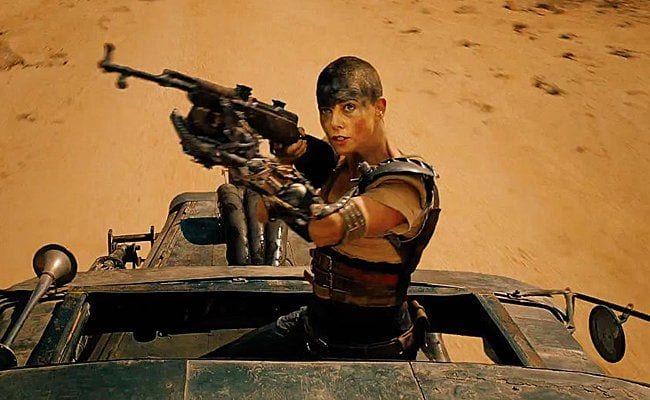
Mad Max: Fury Road is unstuck in time. It’s a film so dramatically dated, and yet so beyond the contemporary culture of shaky cam cinematography and spastically edited action that it appears brand new. In fact, it’s like an electrifying alien transmission, a signal sent long ago from a distant planet to remind moviegoers that not every fight has to be filmed from the participant’s point of view, nor does every car chase have to contain blurred visions of indecipherable vehicular mayhem. Instead, a 70-year-old George Miller steps before this cinematic cult, shows the skill set he’s developed over the last three-plus decades, and then drops the mic.
It’s an amazing accomplishment, a throwback that actually finds a way to return to the present day with its brilliance intact. Comparable to Mad Max 2: The Road Warrior in purpose, Mad Max: Fury Road represents a vision so special, so stubbornly alive, that the work of many others pale in failed comparison. Miller may have jumpstarted the genre at the beginning of the ’80s, his outrageous Aussie aesthetic teaching a tired and trite Hollywood a wonderful series of new tricks, but ever since then, the studios have struggled to keep up. They all used and abused John Woo. They continue to celebrate the stale strategies of Luc Besson. Mad Max: Fury Road is the wake-up call Tinseltown needs.
More or less rebooting both the series and the mythology, we find ourselves in the post-apocalyptic devastation of an atomic bomb-ravaged planet. Max (Tom Hardy) has survived, though he is haunted by his failure to protect his family during the initial chaos. The most precious commodities in this nasty new world order are not oil or gas, but water, and women. In fact, King Immortan Joe (Hugh Keays-Byrne) the leader of a tribe of well drillers, values both so much he has built his car-crazed cult empire out of it. His followers, known as the War Boys, worship him, becoming an army of brainwashed slaves.
During one of Joe’s typical runs to Gas City for supplies, his chief driver Imperator Furiosa (Charlize Theron) goes rogue. She has kidnapped the despot’s harem of baby-making wives, hoping to take them off the grid to “the green place” of her youth. Max becomes an unwilling participant in the leader’s deranged desire to track her down. He’s the “lifeline” to one of Joe’s most ambitious believers, Nux (Nicolas Hoult) and both end up helping Furiosa with her cause. It all leads to a showdown in the desert, with modified vehicles and competing tribes all after what Joe covets.
Bookended by a pair of sublime action sequences and overflowing with imaginative and iconic imagery, Mad Max: Fury Road could actually be subtitled “Mad Maxine”. That’s because Theron as Imperator Furiosa steals the movie away from everyone: the other actors, the writers, the costume designers, art directors, set decorators, and even Miller himself. She is the tired, troubled core here, a woman who knows her way around the backward gender politics of her aggressively male Armageddon. Missing an arm (she occasionally wears a mechanized prosthetic) and painting her face with her truck’s oily greases, she’s both heroine and heartbreak, a reminder of the personal sacrifice this bloodthirsty society mandates and the inherent violence it contains.
Max himself is the opposite. He’s not the center of the story, but merely a catalyst. His arrival doesn’t begin the mutiny, but his instincts certainly help it succeed. During the insurrection, as Furiosa tries to take back what little humanity this arid world has left, Max is stuck in the backseat, sometimes literally. Along with Nux, they argue that men in this domain are helpful, if far from heroes. This is especially true when, at the midway point, the group as to decide on an alternative course of action. While Max comes up with the plan, it’s up to Furiosa to give it the proverbial thumbs up/down — and its eventual drive.
Clearly, everything is set up here for a new franchise of films. We get differing tribes, each with their own unique look and approach to brutality. This is most impressive when Furiosa has to navigate her vehicle through a valley of double-crossing compatriots. As the bad guys ride their enhanced motorcycles up and over the truck, tossing homemade bombs and makeshift spears at our heroes, we sit back and marvel at what Miller has created. This is pure Id flowing from a brain that, until now, didn’t have an outlet for it. You can tell that this former icon has been musing on this project for the last three decades. There is so much detail involved in telling the story of Mad Max: Fury Road that multiple viewings are definitely required.
None of this takes away from the pure adrenaline rush of what this director puts on the screen, however. It’s stunning to witness his vision unfolding, to see how he’s reformulated his concept about this world over the years. The cars are the same, and southern Africa (Namibia, to be specific) may be standing in for Australia, but we are seeing something fully realized with Mad Max: Fury Road, not put together piecemeal by committee. It’s so familiar, and yet so fresh, that the experience creates a kind of electricity that sets the hairs on the back of your neck on end. You’re certain to get goosebumps.
If you don’t want your pulse to quicken, if you don’t care to learn the difference between good old fashioned filmmaking and slipshod genre derivatives, then don’t see Mad Max: Fury Road. You’ll only be missing one of the, if not the best film of 2015 and one of the greatest “second act” action masterworks of all time.


![Call for Papers: All Things Reconsidered [MUSIC] May-August 2024](https://www.popmatters.com/wp-content/uploads/2024/04/all-things-reconsidered-call-music-may-2024-720x380.jpg)



